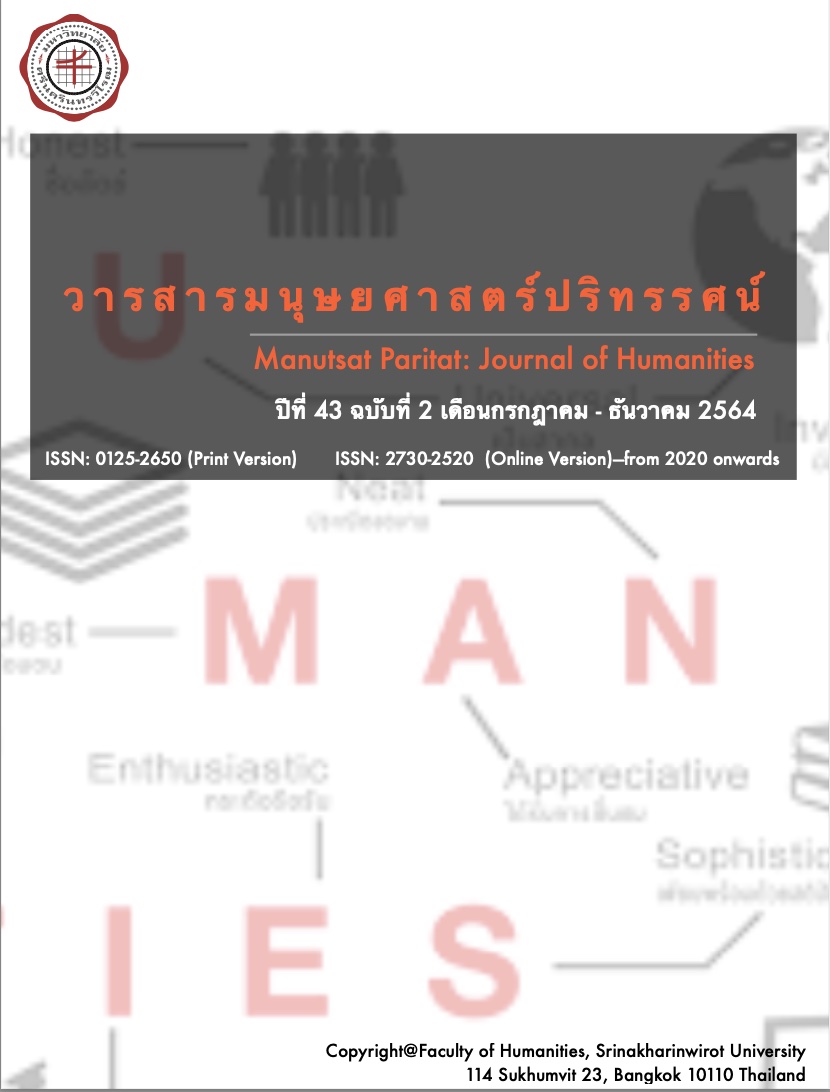Personal Factors and Social Factor Related to COVID-19 Preventing Behavior of Srinakharinwirot University Students
Main Article Content
Abstract
This correlational research aims to study the relationship between personal factors: empathy, situation awareness, self-regulation and social influence on COVID-19 preventing behavior of Srinakharinwirot university students. And to predicted COVID-19 preventing behavior of Srinakharinwirot university students through these factors. The subjects were 120 students in Srinakharinwirot university, which selected the sample by convenience sampling. The data were collected by a questionnaire consisting of 5 parts - empathy, situation awareness, self-regulation, social influence and COVID-19 preventing behavior with a reliability level between .72 to .87. The data were analyzed by Pearson’s Correlation Coefficient and Multiple Linear Regression Analysis through the Enter method. The results of this study were 1) Personal factors (empathy to COVID-19 preventing behavior, situation awareness to COVID-19 preventing behavior and self-regulation to COVID-19 preventing behavior) and social influence to COVID-10 preventing behavior had positive correlation with COVID-19 preventing behavior at a statistical significance level of .001. 2) Personal factors (empathy to COVID-19 preventing behavior, situation awareness to COVID-19 preventing behavior and self-regulation to COVID-19 preventing behavior) and social influence to COVID-19 preventing behavior were able to predict COVID-19 preventing behavior at 47 % at a statistical significance level of .001.
Article Details
Any unauthorized copying, publication, reproduction or distribution of copyrighted works appeared in Manutsat Paritat: Journal of Humanities is an infringement of the copyright owners’ rights. To authorize the copying, publication, reproduction or distribution of copyrighted works to be appeared in other printed materials or any online media, please write to MPJHthaijo@gmail.com for permission.
References
กรมควบคุมโรค. (2563). คู่มือการป้องกันและควบคุมโรคติดเชื้อไวรัสโคโรนา 2019 สำหรับประชาชน. กรุงเทพฯ: โรงพิมพ์ชุมนุม
สหกรณ์การเกษตรแห่งประเทศไทย.
................ (2564). โรคติดเชื้อไวรัสโคโรนา 2019 (COVID-19. เข้าถึงได้จาก
https://ddc.moph.go.th/viralpneumonia/index.php
กรรณิการ์ พันทอง. (2550). การศึกษาและพัฒนาความเห็นอกเห็นใจผู้อื่นของนักเรียนวัยรุ่น. (ปริญญาการศึกษามหาบัณฑิต
สาขาวิชาจิตวิทยาการแนะแนว). บัณฑิตวิทยาลัย: มหาวิทยาลัยศรีนครินทรวิโรฒ.
ดวงกมลชนก ตั้งวิฑูรย์. (2559). ผลการใช้โปรแกรมพัฒนาความเห็นอกเห็นใจโดยใช้บทบาทสมมติของเด็กปฐมวัย. (ปริญญาการ
ศึกษามหาบัณฑิต สาขาวิชาการวิจัยและพัฒนาศักยภาพมนุษย์ แขนงจิตวิทยาการศึกษา). บัณฑิตวิทยาลัย:
มหาวิทยาลัยศรีนครินทรวิโรฒ.
นาถติยา สุภาปุ. (2559). ผลของการใช้โปรแกรมการกำกับตนเองด้านการออกกำลังกายต่อระดับความดันโลหิตในผู้สูงอายุโรค
ความดันโลหิตสูงชนิดไม่ทราบสาเหตุ. (ปริญญาพยาบาลศาสตรมหาบัณฑิต สาขาวิชาการพยาบาลเวชปฏิบัติชุมชน).
บัณฑิตวิทยาลัย: มหาวิทยาลัยนเรศวร.
พลรพี ทุมมาพันธ์. (2554). ผลการใช้โปรแกรมการกำกับตนเองร่วมกับการสนับสนุนทางสังคมของครูที่มีต่อพฤติกรรมของนักเรียน
ระดับประถมศึกษาที่มีผลสัมฤทธิ์ทางการเรียนต่ำกว่าความสามารถที่แท้จริง. (ปริญญาวิทยาศาสตรดุษฎีบัณฑิต
สาขาวิชาการวิจัยพฤติกรรมศาสตร์ประยุกต์). บัณฑิตวิทยาลัย: มหาวิทยาลัยศรีนครินทรวิโรฒ.
มยุรี บญเยี่ยม. (2545). การพัฒนาชุดการเรียนเรื่อง “ความน่าจะเป็น” โดยใชว้ิธีแก้ปัญหาเพื่อส่งเสริมความตระหนักในการรู้คิด
ของนักศึกษาระดับประกาศนียบัตรวิชาชีพชั้นสูง สถาบันเทคโนโลยีราชมงคล. (ปริญญาการศึกษามหาบัณฑิต สาขาวิชา
การมัธยมศึกษา). บัณฑิตวิทยาลัย: มหาวิทยาลัยศรีนครินทรวิโรฒ.
วิลาวรรณ บุญชัง. (2546). การตรวจสอบความเที่ยงตรงเชิงโครงสร้างของแบบทดสอบวัดกระบวนการในการกำกับตนเองในการ
เรียนวิชาคณิตศาสตร์ตามแนวทฤษฎีการเรียนรู้ทางสังคมของบันดูรา. (ปริญญาการศึกษามหาบัณฑิต สาขาวิชาวัดผล
การศึกษา). บัณฑิตวิทยาลัย: มหาวิทยาลัยศรีนครินทรวิโรฒ.
สุริยา ฟองเกิด, สรวงทิพย์ ภู่กฤษณา, มนทรา ตั้งจิรวัฒนา, และสิบตระกูล ตันตลานุกูล. (2560). ปัจจัยที่มีอิทธิพลต่อพฤติกรรม
การสร้างเสริมสุขภาพของวัยรุ่นไทย. วารสารพยาบาลกระทรวงสาธารณสุข. 27, 196-209.
สุรีพร แสงสุวรรณ, วรรณิภา อัศวชัยสุวิกรม, และพรนภา หอมสินธุ์. (2554). ผลของการใช้โปรแกรมการกำกับตนเองด้วยข้อมูล
ทางคลินิกต่อพฤติกรรมการรับประทานอาหารและระดับน้ำตาลในเลือดของผู้ป่วยเบาหวานที่ไม่สามารถควบคุมระดับ
น้ำตาลในเลือด. วารสารคณะพยาบาลศาสตร์ มหาวิทยาลัยบูรพา, 9(3), 54-64.
Bandura, A. (1991). Social Cognitive Theory of Self-Regulation. Organizational Behavior and Human Decision
Processes. 50(2), 248-287.
Endsley, M. R. (1988). Design and evaluation for situation awareness enhancement. In Proceedings of the
Human Factors Society 32nd Annual Meeting (pp. 97-101). Santa Monica, CA: Human Factors Society.
Fisher, J. D., & Misovich, S.J. (1990). Social Influence and AIDS-Preventive Behavior. Retrieved from
https://www.academia.edu/36693176/_1990_Social_Influence_and_AIDS_Preventive_Behavior
Friedkin, N. E., & Johnsen, E. C. (1990). Social Influence and Opinions. Journal of Mathematical Sociology.
(3-4), 193-205.
Goleman, D. (1998). Working with emotional intelligence. New York: Bantam Books.
Hair, J. F., Black, W. C., Babin, B. J., & Anderson, R. E. (2010). Multivariate Data Analysis. (7th ed.). New York:
Pearson.
Jamaludin, S., Azmir, N. A., Ayob, A. F. M., & Zainal, N. (2020). COVID-19 exit strategy: Transitioning towards a
New Normal. Annals of Medicine and Surgery. 59, 165–170.
Jetten, J., Reicher, S., Haslam, S. A., & Cruwys, T. (2020). An Introduction to Social Influence and COVID: Excerpt
from ‘Together Apart’. Retrieved from, https://www.socialsciencespace.com/2020/06/an-introduction-
to-social-influence-and-covid-excerpt-from-together-apart/
Kelman, H. (1958). Compliance, Identification, and Internalization: Three Processes of Attitude Change. Journal
of Conflict Resolution. 2(1), 51–60.
Lee, I. K., Wang, C. C., Lin, M. C., Kung, C. T., Lan, K. C., & Lee, C. T. (2020). Effective Strategies to Prevent
Coronavirus Disease-2019 (COVID-19) Outbreak in Hospital. Journal of Hospital Infection. 105, 102–103.
Li, S., Wang, Y., Xue, J., Zhao, N., & Zhu, T. (2020). The Impact of COVID-19 Epidemic Declaration on Psychological
Consequences: A Study on Active Weibo Users. International Journal of Environmental Research and
Public Health. 17, 2032–2040.
Liao, Q., Cowling, B., Lam, W. T., Ng, M. W., & Fielding, R. (2010). Situational Awareness and Health Protective
Responses to Pandemic Influenza A (H1N1) in Hong Kong: A Cross-Sectional Study. Retrieved from
https://journals.plos.org/plosone/article?id=10.1371/journal.pone.0013350
Moudatsou, M., Stavropoulou, A., Philalithis, A., & Koukouli, S. (2020). The Role of Empathy in Health and Social
Care Professionals. Retrieved from https://www.ncbi.nlm.nih.gov/pmc/articles/PMC7151200/
Pfattheicher, S., Nockur, L., Böhm, R., Sassenrath, C., & Petersen, M. B. (2020). The Emotional Path to Action:
Empathy Promotes Physical Distancing and Wearing of Face Masks During the COVID-19 Pandemic. Psychological Science. 31(11) 1363–1373.
Qazi, A. et al. (2020). Analyzing Situational Awareness through Public Opinion to Predict Adoption of Social
Distancing Amid Pandemic COVID-19. Journal of Medical Virology. 92, 849–855.
Tunçgenç, B., et al. (2021) Social influence matters: We Follow Pandemic Guidelines Most When Our Close
Circle Does. British Journal of Psychology. 1-18. doi.org/10.1111/bjop.12491


